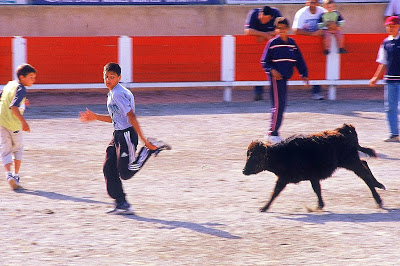
La Feria Corridas—the bullfighting festival—is so firmly ingrained in the Easter traditions of the Camarague area that, in this south western area of Provence, “Feria,” which means “festival,” seems to be synonymous, this time of year, with both Easter and bullfighting. In the main bullfighting arenas—Arles and Nîmes—as well as in the many small towns that set up temporary arenas, Easter weekend marks the start of bullfighting season.
We found ourselves in Aigues-Mortes one Easter weekend several years ago. And there, in one of the small, non-descript arenas temporarily assembled for La Feria, we learned about course camarguaise.
Aigues-Mortes, which comes from the Occitan language and means “Dead Waters,” actually lies just outside of Provence, in the Gard Department of the Languedoc-Roussillon region. But, like Nîmes and the Pont du Gard, they often get lumped into the list of worthy stops on a trip to Provence.
The Camargue is an approximate 350 square mile area of fabulous wilderness wedged between Arles and the Mediterranean Sea where the Bouche-du-Rhone meets the Gard department. Created over the centuries by the sediment from the Rhone River, one third of it is composed of water: seasonal marshes, lagoons, and salty plains. The northern part is a major rice producing area and the delta is a major salt producing area. Much of the rest of the Camargue is protected as a nature conservation area called the Parc Naturel Regional de Camargue. Commercial activity is severely limited by law, thereby protecting the black bulls, white Camargue horses, pink flamingos, and over 400 species of other birds. Although we have only seen the bulls in the arena, we have, on one trip or another, seen everything else, including an occasional gardian, otherwise known as a Carmargue cowboy! It’s is a beautiful area.
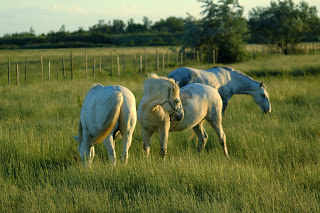 |
| Three Horses in a field Photo: Barbarossa |
Until you get to Aigues-Mortes. It is really a shame that the well-preserved thick walls and tall towers that surround this 13th century city can’t be used to protect it from the hordes of tourists that descend upon it every weekend. But they and the tacky stores that line the medieval streets were probably what propelled us to explore other areas and discover La Feria.
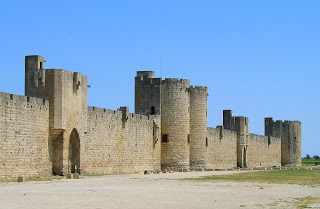 |
| Walls surrounding Aigue Mortes Photo: I, MJJR |
There are two types of bullfights in the South of France. The Spanish-style, course corrida, is the kind most people are familiar with; although long a part of the Spanish culture and increasingly popular in the South of France since their introduction in 1853, these events are controversial, bloody, and gory.
In contrast, the course camarguaise (also called the course libre) is bloodless—at least for the bulls! The object is to grab the rosette tied between the horns of the bull. Each participant, called a raseteur, carries a hook, called a raset, with which he (or she) attempts to retrieve the rosette. A small group of raseteurs enters the ring with the bull and the game begins. Whoever snatches the raset first wins. I think that there may have been more than one raset in the matches we watched. A lot of time is spend running—running for one’s life or at least one’s limb, it appeared to me! Each rendezvous lasts about 15-20 minutes. The bulls are not killed—they are said to die of old age—and the bravest are honored with statues
We seemed to have stumbled upon the preliminary show of novice raseteurs as some of the participants seemed quite young, having barely reached puberty. Another group looked to be in their late teens and twenties. There was one older man who seemed to have hit the pastis before entering the ring.
The crowd was sparse…but very enthusiastic. They oohed and ahhed and occasionally squealed with delight after a successful maneuver, one that made my knees wobble. There was a lot of milling around, chatting with one another outside the stands. Our daughter found a few children to play with (outside the ring!). We learned about the “bullfighting” by talking with those around us who were eager to educate us. It was clearly a community event.
I thought of the soccer matches we attended at home where we watched our daughter play and, like here, the spectators were entirely family and friends….but, at home, we were watching balls—not bulls! And one of the raseteurs was definitely a liability to the city of Aigues-Mortes although only us suit-conscious Americans seemed concerned.
We could have participated that Sunday in Aigues-Mortes! The announcer invited any raseteur wannabes to enter the ring. I encouraged my husband—Camargue bulls are a small breed and they had rubber balls on the tips of their horns—but he wouldn’t budge. I figured that I didn’t speak enough French (mercifully).
The people of the Carmargue know bulls. They are part of their culture and their local cuisine. The Camargue bulls have roamed the area for 2000 years, since Roman times.
The international organization, CAS (Comité Anti Stierenvechten) which is the largest group working toward the abolition of bullfighting, is also against courses camarguaises on the alleged grounds that they cause the bulls to suffer from stress, exhaustion, and sometimes pain.
As our world becomes smaller, we increasingly come face-to-face with social mores that may differ sharply from our own and that we may find difficult to reconcile with our own values and beliefs. Within our own culture, of course, we may not share the same views. We all have to make our own decisions. I try to keep an open mind and to step into the shoes of others.
Courses camarguaises–really more bull games than bull fights–made for a fun afternoon for us, full of spirit and camaraderie.
La Feria in Aigues-Mortes begins April 8th and bullfighting continues every Sunday through June. For more information, click here. La Feria in nearby Arles takes place April 6th through 9th. For more information, click here and contact the office of Tourism for dates of other bullfights.
So, next weekend the bullfights commence…it must be Easter in Provence!
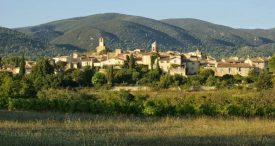
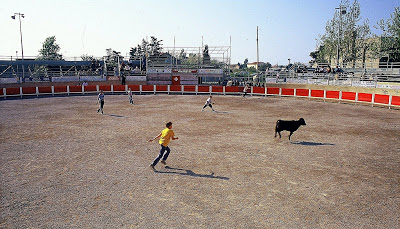
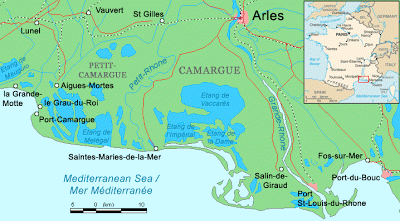
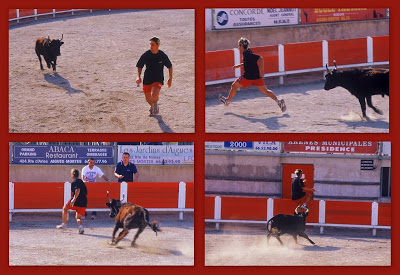
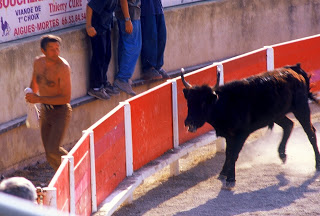
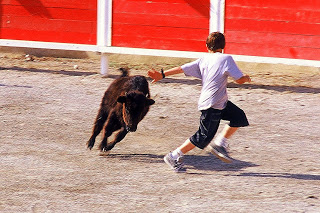
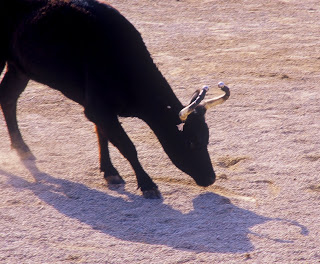
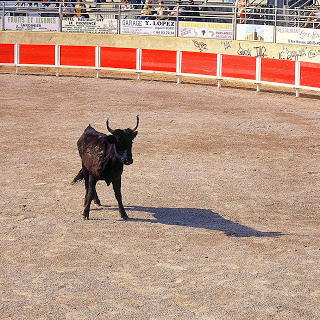
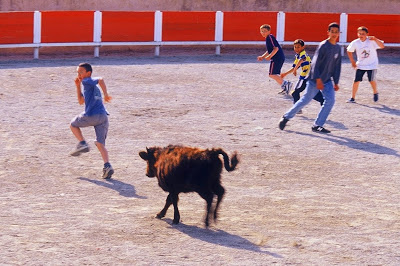
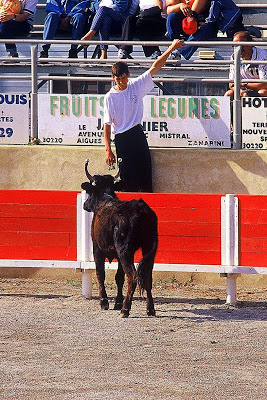





I did like Aigues-Mortes–we were there on a rainy day in 2003 and it must have been in the middle of the week because I don't remember many tourists.
We ate at a marvelous restaurant, La Salicorne stayed too long and were driving home in dark among the trucks hell bent for Lyon! We had to go all of the way to Orange for the crossover to "our" side of the river.
The courses camarguaises reminds me a lot of the Tucson Rodeo in February! While rodeo isn't all that popular in some circles, it is a tradition and a way of life. Vive la différence! While I have said I would never attend a bull fight, I might just head over to the Camargue sometime for Easter week!
An interesting andwell written story about bull fighting. Each story seems to bring back memories that were long forgotten.
The bull fights in LaFeria are pretty tame compared to the ones that we went to in Mexico. We used to load up the family(yes, children were allowed)and on the way to the bull ring, my brother-in-law, who was an expert on Mexican culture, would prep us with a lesson on the history of bull fighting. "These bulls were raised to be used in the ring, he used to say,Their sole purpose in life was to fight and die in the ring. After the Matador kills the bull, the carcass is immediately taken to a charitable organization that feeds the poor. That was their noble reward".
Upon our arrival at the arena. we would purchase our seat cushions. They were hand made of scraps of colored leather, a real work of art. Compared to cushions these days, our cushions were small. The size seemed more proportioned to the slim hips and posteriors of the toreadors. Todays fans would need at least two!!
We tried to sit up high and above the fray because if the fans didn't like the toreador or the end results of the match, they would throw their cushions toward the ring,not caring who they hit. We always left feeling lucky to have survived.
It made me think of those anciant Biblical perple who were entertained by the matches that were held in the Roman Coliseum, and were we to compare them,some might say "Cruel and uncivilized". Who's to say ? That decision is still, ultimately, in the eye of the beholder.
Hi Mary,
Thanks for defending Aigues-Mortes. I would enjoy revisiting Aigues-Mortes in the off-season as those fabulous ramparts must be fun to explore. I suppose that one could describe Carcassone similarly–that magnificent 13th century walled city (with origins predate the Romans by several thousand years!) is often filled to the brim with tourists (like ourselves), too, but it wasn't when we were there and I would jump at the chance to return.
Thanks for the restaurant recommendation, too!
Amitiés,
Susan
It would be a fun road trip. Mary, who lives in New England but whom I met in Lourmarin, has provided a restaurant recommendation! We could start in Paris and hear the new bells in Notre Dame when they debut on Palm Sunday 2013 and then head south! Let's go!
Amitiés,
Susan
I agree that we should tread lightly into another culture's traditions. There are certainly some practices that the vast majority of the world–the eyes of most beholders– find so morally repugnant that we are compelled to voice our opposition, but most customs that have withstood the test of time have carved out a place in that culture even if they are controversial. Of course, cultures change over time and what was once largely acceptable may now be abhorrent…but, as you suggest, who are we to judge those of the past?
I attended quite a few bullfights as a child with the same kind of mindset you are describing. I'm not sure that I saw them much differently than a professional football game (a sentiment the reader can interpret in several ways!).
Thanks for your candid and very interesting thoughts.
Amitiés,
Susan
Susan,
I don't attend bullfights. Nor do I attend professional hockey games. Is there a difference? No, I think not.
But…I would relish the opportunity to attend the bull games you are describing!
Your story brought back memories of when we were a little younger and went to the bull fights in Mexico City.I think I still have one of leather pillows we would thro to the Matador if he gave a good performance.I still have it so I guess it was a poor showing!I,d better go check-be right back!
P.S. I'msure Mr. Manfull has the bulls!
Brother John
There is a bill before the assembly in Mexico City that would ban the very bullfights we used to see in Mexico City. Apparently, it is likely that they will approve it, making bullfights illegal. The main reason there is such debate, I gather, is not because it is considered a cultural tradition but because it would negatively impact employment of so many people. In the country, there are around 225 bullrings and around 22 bullfighting schools. All that said and at the risk of appearing to be like the Adams Family, we certainly had fun.
S
Easter weekend in the Camargue, Nîmes, and Arles!